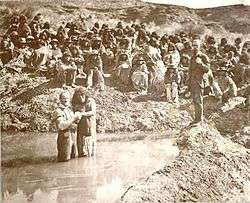Shivwits Band of Paiutes
The Shivwits Band of Paiutes is a band of the Paiute Indian Tribe of Utah, a federally recognized tribe of Southern Paiutes in southwestern Utah.
Name
Shivwits comes from a Southern Paiute word, sipicimi. The word may be based on the prefix sibi-, meaning "east" or si-vints, meaning "people who live in the east." It is also spelled Shivwitz, Shi'-vwits, She-bits, Sübü'ts, and Sebit. The Shivwits Plateau in Arizona is named after the tribe.[1] Today the Shivwits Band of Paiute Indians of Utah identify as See’veets eng, meaning "Whitish Earth People".[2]
History

The Shivwits Paiutes settled in Utah around 1100 BC. They hunted rabbits, deer, and mountain sheep and gathered seeds, roots, tubers, berries, and nuts, particularly pine nuts. They were farmers living along the Santa Clara River and the Virgin River and cultivated crops of corn, squash, melons, gourds, sunflowers, and, after European contact, winter wheat.[3]
The Domínguez–Escalante expedition of 1776 was most likely the Shivwits' first contact with Europeans. Fur trader Jedediah Smith created a route to California directly through Paiute territory. The 19th century brought non-Native trappers, traders, and settlers to the area. The newly introduced livestock had a negative effect on the area's delicate ecology. Utes and Navajos often captured Paiute women and children and sold them to European-Americans as slaves. Mormons permanently settled on Paiute lands in the 1850s, putting an end to the Shivwits' traditional lifestyle.[3]
Their reservation was formed in 1891. It did not receive water rights so they were forced to abandon farming.[4] The reservation had a population of 194 in that year. There were 154 Shivwits in 1906.[5] The Shivwits Band of Paiute Indians of Utah first received federal recognition on March 3, 1891 as the "Shebit tribe of Indians in Washington County, Utah."[3]
Along with other Utah Paiute tribes, the Shivwits' relationship with the federal government was terminated in the 1950s.[6] Unlike other Paiute groups the Shivwits retained ownership of their lands after termination and leased them to ranchers, instead of selling them outright.
Recent developments
The Shivwits regained federal recognition through an act signed by President Jimmy Carter on 3 April 1980.[3][6] The reservation is larger than it was originally, covering 28,480 acres.
In 2003 the Shivwits received water rights for 4,000 acre feet (4,900,000 m3) annually, enabling the tribe to create new economic development projects.[4]
Today
The tribe is headquartered in Ivins & the unincorporated community of Shivwits, located in Washington County, Utah. Their Band Chairperson is Jetta Wood.[3]
References
- d'Azevedo, 396
- Paiute Indian Tribe of Utah: Tribal Bands
- "Shivwits Band of Paiutes." Paiute Indian Tribe of Utah. 2009 (retrieved 7 Dec 2009)
- "U.S. accord gives water to Shivwits." Deseret News. 20 Nov 2003 (retrieved 31 Oct 2012)
- "Paiute Indian Tribe History." Access Genealogy. (retrieved 7 Dec 2009)
- Pritzker, 231
Sources
- D'Azevedo, Warren L., Volume Editor. Handbook of North American Indians, Volume 11: Great Basin. Washington, D.C.: Smithsonian Institution, 1986. ISBN 978-0-16-004581-3.
- Pritzker, Barry M. A Native American Encyclopedia: History, Culture, and Peoples. Oxford: Oxford University Press, 2000. ISBN 978-0-19-513877-1.